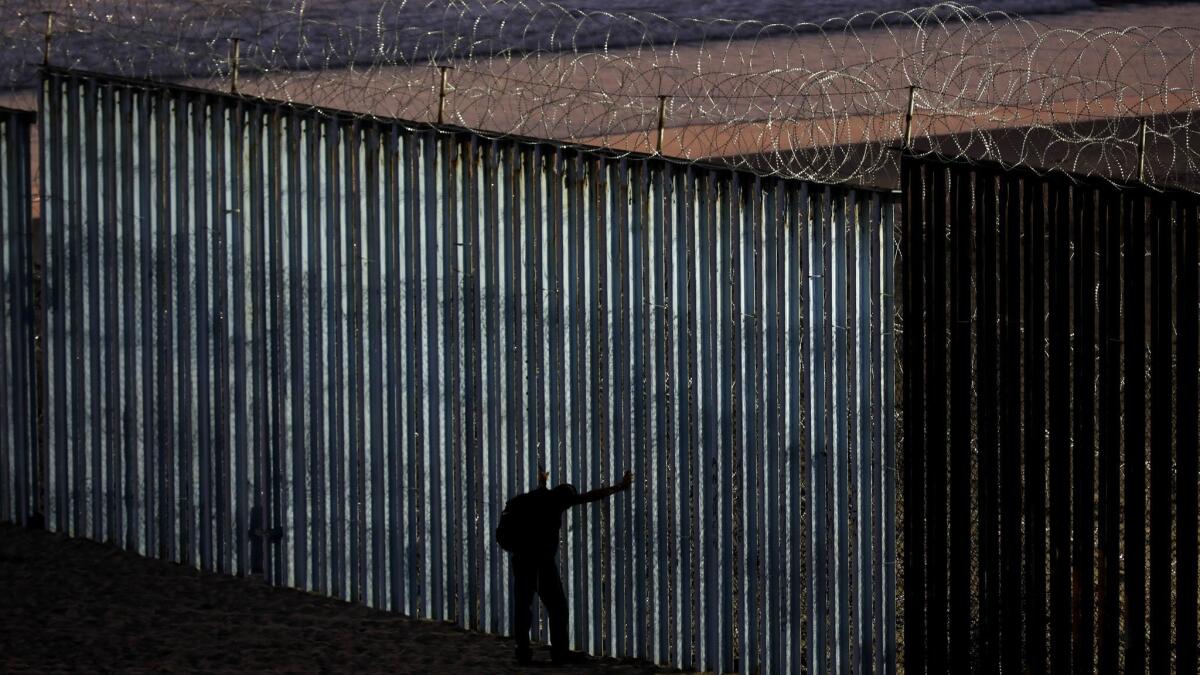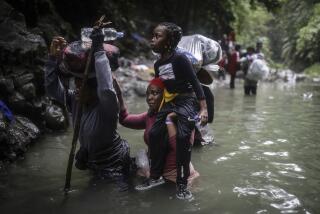Experts are skeptical that a Trump border wall would reduce human trafficking

In President Trump’s repeated calls for a border wall, he has recently turned his focus to the horrors of human trafficking along the southern border.
“Even one woman or one child trafficked is too many,” Trump said in a Feb. 1 speech at the White House. “But there are thousands and thousands and thousands…”
While a presidential platform is often appreciated on social issues, some trafficking victim advocates say the focus ignores the broader picture of trafficking in the United States.
“Claims that a wall will stop vast amounts of human trafficking are not only inaccurate and misleading,” Bradley Myles, chief executive of Polaris, a nonprofit organization that runs the National Human Trafficking Hotline, said in a statement, “they also harm our efforts to educate the public on the true nature of this crime.”
So what is the relationship between human trafficking and the border? And who are the people being trafficked in the United States?
It’s not the easiest population to track, given the hidden, illicit nature of the business. There’s also no single clearinghouse for tracking cases. But growing awareness, enforcement and research on the issue have provided some key insights into the situation.
Here is a look at how those findings match up with Trump’s statements:
“Much of it comes — in fact, most of it comes — some people would say almost all of it — from the southern border …” (Trump, Feb. 1 speech on human trafficking)
That conclusion is not supported by several global and local organizations that track data on tens of thousands of human trafficking cases in the country. Instead, the data show that the majority of victims are born in the U.S.
Human trafficking is defined as the use of force, fraud or coercion against another person to perform labor, services or commercial sex acts. It sometimes goes hand-in-hand with human smuggling — the transportation of people illegally across borders — but oftentimes does not, the U.S. Department of Justice pointed out in a 2017 bulletin for prosecutors on human trafficking.
The U.S. Department of State’s 2018 Trafficking in Persons report names the United States as the top country of origin of federally identified victims in fiscal 2017 followed by Mexico and Honduras. The report does not break down the ratios.
Of the callers into Polaris’ national hotline whose nationalities are known — about 14,000 — the breakdown from 2015 to mid-2018 is a near equal distribution between U.S. citizens/legal permanent residents and foreign nationals, said spokesman Brandon Bouchard.
Of the foreigners, those from Mexico topped the list with more than 1,500, followed by the Philippines, Guatemala, China and Honduras.
The Counter-Trafficking Data Collaborative, described as a global data hub on human trafficking, drills down similar findings by state. For instance, in California, 61% of the victims in the data set are U.S.-born, 8% Mexican and 7% Chinese.
According to the study co-written by Jamie Gates, director of the Center for Justice and Reconciliation at Point Loma Nazarene and a human trafficking researcher, with University of San Diego researcher Ami Carpenter in 2015, most of the sex trafficking in San Diego County involves American teenage girls and young women who are recruited where they spend much of their time — at school, the mall, trolley stops, on social media — by typically gang-involved “Romeos” who pretend they are romantically interested and eventually manipulate them into prostitution.
“Runaway and homeless youths — male, female, and transgender — are at particularly high risk for becoming victims, though some trafficked youths continue living at home and attending school,” according to the report “Human Trafficking in America’s Schools” by the National Center on Safe Supportive Learning Environments. “There is also a strong correlation between sexually exploited youths and childhood sexual abuse, chronic maltreatment and neglect, and otherwise unstable home environments.”
The study estimates an average of 5,000 trafficking victims in the San Diego County.
The San Diego Human Trafficking Task Force primarily works these domestic cases, with 18 detectives from 13 federal, state and local agencies. In San Diego, victim advocates are also seeing reverse trafficking — U.S. citizens, mostly teens, being taken to Tijuana, Rosarito and Ensenada, Mexico, for sexual exploitation.
“They can easily rent a house over there, do things in houses, then come back after the weekend,” said Marisa Ugarte, founder of the Bilateral Safety Corridor Coalition, a cross-border nonprofit organization based in San Diego.
“You can’t take human traffic — women and girls — you can’t take them through ports of entry. You can’t have them tied up in the backseat of a car or a truck or a van. They open the door. They look. They can’t see three women with tape on their mouth or three women whose hands are tied.” (Trump, Feb. 15, Rose Garden speech)
“Human trafficking by airplane is almost impossible. Human trafficking by van and truck, in the backseat of a car, and going through a border where there’s nobody for miles and miles, and there’s no wall to protect — it’s very easy.” (Trump, Feb. 1)
Experts say violent kidnapping to transport victims across international lines happens.
But they add that the vast majority of international trafficking is done through psychological manipulation, fraud and coercion. Victims are isolated, demeaned, intimidated, made to feel dependent upon their traffickers and threatened with dire consequences if the victim tries to leave, according to the 2017 Department of Justice bulletin for prosecutors.
Many victims don’t even realize they are being trafficked at first; they are willing participants on the journey, not aware of what lies ahead.
Experts say many of those traveling by air — notably those from Asian, Middle Eastern and African countries — are lured by a tactic known as “bait and switch.”
“People come under legal pretense with sponsors. Then a supposed work relationship turns into a coerced environment and into trafficking,” Gates said. “By far, that’s the most common form of international trafficking we see.”
That tactic is frequently used to lure victims to do sex work in massage parlors, or to labor in nail salons, factories, restaurants, as home-health aides or domestic servants.
Worldwide, journeys for labor trafficking victims are more likely to go through official ports of entry, including airports, either with legal or fraudulent travel documents, according to data collected by the United Nations’ International Organization for Migration over the past 10 years. Sex trafficking victims, and children, are more likely to enter at non-official crossings.
Airports around the world have recently begun to take the threat of human trafficking seriously, with many posting signs offering help to victims and a hotline number to call. At the San Diego International Airport, the signs are posted near screening points and in the international terminal.
Ugarte, who runs a shelter in San Diego County for foreign victims, said she has seen Filipino migrants trafficked in the healthcare industry, and she recently helped an Indonesian woman who was brought over for domestic servitude.
“I have a 60-year-old Chinese woman with me who doesn’t speak a word of English,” she said. “They tell her to work at a massage parlor, force her to do ‘happy endings,’ she says ‘no,’ she goes hysterical. They take her papers away and pretend she never worked there.”
Davis is a writer for the San Diego Union-Tribune.
kristina.davis@sduniontribune.com
More to Read
Start your day right
Sign up for Essential California for news, features and recommendations from the L.A. Times and beyond in your inbox six days a week.
You may occasionally receive promotional content from the Los Angeles Times.






